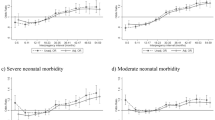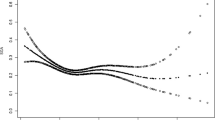Abstract
Objective:
To estimate the effect of parity on gestational age (GA) at birth in multifetal pregnancies.
Study Design:
Birth data from the public-access Matched Multiple Birth File produced by the National Center for Health Statistics from 1995 to 2000 were analyzed following IRB approval. GA, parity and demographic data were analyzed with parametric and nonparametric tests, including regression analysis, using SPSS.
Result:
Data from women with twin (n=316 983), triplet (n=11 981), and quadruplet (n=766) pregnancies were analyzed. A significantly higher proportion of nulliparous versus parous women were Caucasian (twins: 82 versus 77%; triplets: 91 versus 87%) and had more than 15 years of education (twins: 39 versus 24%; triplets: 55 versus 39%; quadruplets: 53 versus 35%). Mean GA was 5.6 days longer for twins, 5.4 days longer for triplets and 6.8 days longer for quadruplets born to parous versus nulliparous women. Caucasian and African-American parous women pregnant with twins or triplets delivered their babies at a later GA than their nulliparous counterparts at each level of education. GA at delivery increased as a function of age of the mother in nulliparous and parous women of twins or triplets, and at every age level, parous women delivered their babies at a later GA. A higher proportion of nulliparous women delivered before 24 weeks (twins: 2.9 versus 1.2%; triplets: 5.9 versus 2.5%; quadruplets: 8.3 versus 2.6%). The percentage of twins born at or after 32 weeks was 84.9% for nullipara and 90.1% for parous women; for triplets, corresponding figures were 61.4 and 69.6%; and for quadruplets the figures were 33.2 and 44.2%. The percentage of births at or after 36 weeks for nulliparous and parous women pregnant with twins was 54.8 and 63.2%, respectively. The majority of the gain in GA was observed between women who had no previous births and those who had one previous birth. In regression analysis, the effect of parity remained after controlling for demographic and risk factors known to affect GA.
Conclusion:
GA at delivery is significantly increased in parous women carrying a multifetal gestation after controlling for other factors that affect GA at birth.
This is a preview of subscription content, access via your institution
Access options
Subscribe to this journal
Receive 12 print issues and online access
$259.00 per year
only $21.58 per issue
Buy this article
- Purchase on Springer Link
- Instant access to full article PDF
Prices may be subject to local taxes which are calculated during checkout




Similar content being viewed by others
References
Slattery MM, Morrison JJ . Preterm delivery. Lancet 2002; 360 (9344): 1489–1497.
ACOG Committee on Practice Bulletins. American College of Obstetricians and Gynecologist. ACOG Practice Bulletin. Clinical management guidelines for obstetrician-gynecologist. Number 43, May 2003. Management of preterm labor. Obstet Gynecol 2003; 101 (5 Part 1): 1039–1047.
Tucker J, McGuire W . Epidemiology of preterm birth. BMJ 2004; 329 (7467): 675–678.
Ananth CV, Vintzileos AM . Epidemiology of preterm birth and its clinical subtypes. J Matern Fetal Neonatal Med 2006; 19 (12): 773–782.
Salihu HM, Aliyu MH, Rouse DJ, Kirby RS, Alexander GR . The association of parity with mortality outcomes among triplets. Am J Obstet Gynecol 2004; 190 (3): 784–789.
Tarter JG, Khoury A, Barton JR, Jacques DL, Sibai BM . Demographic and obstetric factors influencing pregnancy outcome in twin gestations. Am J Obstet Gynecol 2002; 186 (5): 910–912.
Aina-Mumuney AJ, Rai KK, Taylor MY, Weitz CM, Chisholm CA . Nulliparity and duration of pregnancy in multiple gestation. Obstet Gynecol 2004; 104 (1): 110–113.
ftp://ftp.cdc.gov/pub/Health_Statistics/NCHS/datasets/mmb2/ accessed March 2006.
Kelly MM . The basics of prematurity. J Pediatr Heath Care 2006; 20: 238–244.
Garite TJ, Clark RH, Elliott JP, Thorp JA . Twins and triplets: the effect of plurality and growth on neonatal outcome compared with singleton infants. Am J Obstet Gynecol 2004; 191 (3): 700–707.
Reddy UM, Wapner RJ, Rebar RW, Tasca RJ . Infertility, assisted reproductive technology, and adverse pregnancy outcomes: executive summary of a National Institute of Child Health and Human Development workshop. Obstet Gynecol 200; 109: 967–977.
Centers for Disease Control and Prevention (CDC). Contribution of assisted reproductive technology and ovulation-inducing drugs to triplet and higher-order multiple births—United States, 1980–1997. MMWR Morb Mortal Wkly Rep 2000; 49 (24): 535–538.
Helmerhorst FM, Perquin DA, Donker D, Keirse MJ . Perinatal outcome of singletons and twins after assisted conception: a systematic review of controlled studies. BMJ 2004; 328 (7434): 261.
Lynch A, McDuffie R, Stephens J, Murphy J, Faber K, Orleans M . The contribution of assisted conception, chorionicity and other risk factors to very low birthweight in a twin cohort. BJOG 2003; 110 (4): 405–410.
Chandra A, Martinez GM, Mosher WD, Abma JC, Jones J . Fertility, family planning and reproductive health of U.S women: Data from the 2002 National Survey of Family Growth. National Center for Health Statistics. Vital Health Stat 2005; 23 (25): 1–160.
Wier ML, Pearl M, Kharrazi M . Gestational age estimation on United States livebirth certificates: a historical overview. Paediatr Perinat Epidemiol 2007; 21 (2): 4–12.
Mathews TJ, MacDorman MF . Infant mortality statistics from the 2004 period linked birth/infant death data set. Natl Vital Stat Rep 2007; 55 (14): 1–32.
Acknowledgements
We thank Richard Steiner PhD, The University of Akron, for his contributions to the statistical analysis.
Author information
Authors and Affiliations
Corresponding author
Rights and permissions
About this article
Cite this article
James, S., Gil, K., Myers, N. et al. Effect of parity on gestational age at delivery in multiple gestation pregnancies. J Perinatol 29, 13–19 (2009). https://doi.org/10.1038/jp.2008.121
Received:
Revised:
Accepted:
Published:
Issue Date:
DOI: https://doi.org/10.1038/jp.2008.121
Keywords
This article is cited by
-
Spontaneous fetal reduction in triplets and prolongation of twin pregnancy for 111 days as an outpatient: a case report
Journal of Medical Case Reports (2021)



